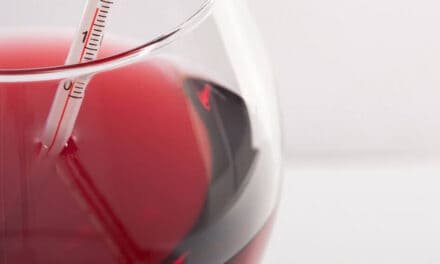For many wine lovers, drinking and talking about wine is an event. And to celebrate this event properly, they use many special terms to describe what they see, smell, and taste. For non-experts, this vocabulary might be confusing at first sight. But with some practice, anyone can learn to describe the taste of wine in a meaningful and consistent way.
You can describe the taste of wine based on four broad categories: fruit level, sweetness, body, and finish. The fruit level determines the flavor profile of the wine. Sweetness is a range that describes how much residual sugar is in the wine. The term body describes how the wine feels on the tongue. The finish is an explanation of the wine’s aftertaste.
Wine experts know many different terms for each of these categories. Some of them have a rather broad meaning and are interchangeable. Others refer to particular details of the taste of wine. To understand this vocabulary and use it correctly to describe the taste of wine, we will discuss the broad categories one by one and break them down into more specific subcategories and single terms.
By the way: Some experts claim that you might stimulate your brain more when you drink and describe the taste of wine than when you do maths; so, if you want to keep your mind sharp, grab a glass and talk about it.
HOW TO DESCRIBE THE TASTE OF WINE BASED ON ITS FLAVOR PROFILE
Fruit levels in wine identify the main flavor profile. There is an abundance of categories and terms for describing what a wine’s primary flavors are.
If you’re new to the world of wine, the most straightforward approach is to start with very two broad categories: Fruity and savory. They mark the extreme points on a spectrum. Most wines lean toward one of the two sides, but it is possible to find wines that incorporate both fruity and savory characteristics.
You can identify whether a wine is fruity or savory by smelling and tasting it. Primarily your nose will provide you with valuable hints to make this distinction. Of course, your ability to detect aromas depends on your memory. If you have never smelled a strawberry, an orange, or a plum before, you will have a hard time identifying fruity wine flavors. And, of course, you will struggle to describe the taste of wine based on fruit aromas.
Fruity Wines
Fruity wines offer intensive fruit flavors such as strawberries, apples, lemons, peaches, and others. Besides, they often contain floral notes. As both fruity and floral flavors work best when standing on their own, these wines typically do not offer many other aromas. Oaky, nutty, or earthy notes are rare in fruity wines. However, they might occasionally show up as subtle undertones.
Be aware that fruity is not the same as sweet. Your brain might trick you into thinking that. The reason is that it associates the fruit flavors with sweetness. But actually, many fruity wines are dry, not sweet. We will discuss this distinction later in this article.
To describe fruity wines, it is best practice to state what fruits and flowers you notice in the process. To that end, common fruit aromas to sense in wines include:
- red fruits like raspberry, strawberry, cranberry, cherry; very common in red and rosé wines
- black fruits such as blackberry, black currant, plum, fig ; common in red wines
- tree fruits like apple, pear, apricot, peach ; very common in light white wines
- citrus fruits, for instance, lemon, orange, lime, grapefruit ; very common in white wines
- tropical fruits like mango, melon, pineapple ; common in oak-aged white wines
The following wines usually are fruity:
- Beaujolais
- Grenache / Garnacha
- Malbec
- Merlot
- Moscato
- Pinot Noir
- Riesling
Savory Wines
Savory wines often are complex and include a broad range of aromas. They offer nutty and spicy flavors such as clove, cinnamon, vanilla, tobacco, or coffee. Earthy and woody notes are typical as well. You might sense leather, forest floors, mushrooms, and oak (especially if the wine aged in oak barrels).
Fruity flavors can be part of the bouquet of savory wines, but they are typically rather acidic or tart. Examples are aromas of ripe red or black fruits like cherries, plums, or blackberries. Light fruity flavors of citrus fruits or apples in savory wines are very rare.
“Savory” is not the only term experts use to describe savory wines. Other words are a bit more specific and give a better idea of the aromas you sense in a wine:
- Spicy
- Earthy
- Oaky
- Rich
- Buttery
Here are some examples of savory wines:
HOW TO DESCRIBE THE TASTE OF WINE BASED ON SWEETNESS
Sweetness is the second essential characteristic of wine. You can describe the taste of wine based on a sweetness spectrum but with more precise distinctions. Typically, wine experts differentiate between five levels of sweetness:
- bone-dry
- dry
- off-dry
- semi-sweet
- sweet
This categorization is based on the amount of residual sugar in the wine after the fermentation and aging process. And the amount of residual sugar depends on various factors:
- The Varietal: Some grape varieties naturally contain more sugars than others by nature. So vintners aiming to make sweet wine choose other grapes than those who prefer to produce dry wines.
- The Climate and Weather: Sunshine and hot temperatures allow grapes to ripen faster and accumulate more sugar. So grapes from New World wine countries like Australia, California, or South Africa typically have more sugar than grapes from Old World countries such as France, Germany, or Italy. Besides that, a sunny year produces sweeter wines than a rainy year.
- The Fermentation Process: The longer the crushed grapes ferment, the more sugar transforms into alcohol. The result is a dryer wine with higher alcohol content.
The perceived sweetness that you sense in wine might differ from its actual sweetness. The reason is that other components can balance the residual sugar, so it is less perceivable. The most important among them are tannins and acidity.
Tannins are compounds that are present in all wine grapes but also in tea, coffee, and other plants. Their bitter taste and the mouth-drying sensation they create help to balance the sweetness of residual sugar.
The same goes for acidity. A wine with a significant acidity level tastes less sweet than a low-acidity wine, even if it contains the same amount of residual sugar.
In any case, you should describe the taste of wine based on your perceptions, not on what you have read on the bottle label.
The level of residual sugar is expressed in grams per liter of wine. The following table shows a common categorization. But depending on the winemaking country, the values can vary. For instance, the European Union prescribes other minimum and maximum sugar levels for various categories.
Wine Sweetness by Sugar Content
Bone Dry Wine
Bone dry wines can be red or white, but actually, they are fairly rare. They have almost no residual sugar left in them, and most of them are also high in tannins.
Be aware that no wine has no sugar at all. The reason is that some types of grape sugar, such as Pentose, do not ferment into alcohol. So even a bone-dry wine contains a tiny amount of residual sugar.
Examples of bone-dry wines are Chianti Classico, Barolo, Barbaresco, and Muscadet.
Dry Wine
The majority of wines are considered dry, with only little residual sugar. The reason is that a small amount of sugar makes it easier for vintners to balance acidity and tannins and give their wine a distinct character. Thus, they allow most, but not all, of the sugar to ferment. The result is a dry wine.
Especially red wines tend to fall into the dry category, although many white wines do as well. Some famous examples are Cabernet Sauvignon, Merlot, and Zinfandel on the red side and Chardonnay, Pinot Gris, and Sauvignon Blanc on the white side.
Off-Dry Wine
Off-dry wines contain just a bit more sugar than dry wines. In contrast to dry wines, off-dry styles often feature a perceivable but mild sweetness. But once again, acidity plays a large role. When off-dry wines are not acidic, they can often taste just as sweet as semi-sweet wines. On the other hand, a significant acidity level can make an off-dry wine taste similar to a dry wine.
Many whites, such as Riesling or Gewürztraminer, belong to this category, though occasionally red wines do so as well.
Semi-Sweet Wine
Even with a significant level of acidity, it is hard to mask the residual sugar in semi-sweet wines. Many of these wines are late-harvest or noble-rot wines. And so do sweet sparkling wines like Lambrusco, Brachetto d’Acqui, or Moscato d’Asti, but also sweet Riesling wines.
Sweet and Very Sweet Wine
Sweet wines are often classified as dessert wines due to their high sugar content and abundant sweetness. Ice wines, Port, Madeira, Sherry, and many other fortified wines are sweet. Some of them even contain more sugar per liter than soft drinks like Coca-Cola.
HOW TO DESCRIBE THE TASTE OF WINE BODY
The third important characteristic is wine body. It describes the feeling that it gives you on the tongue and in the mouth. And to describe the taste of wine based on its body is actually fairly easy because it is so obvious. All wines belong to one of three categories:
- Light-bodied
- Medium-bodied
- Full-bodied
To understand the concept of mouthfeel, imagine drinking iced tea and how it feels light and airy in your mouth. Next, think of full milk. It is much heavier and coats your tongue. Both may be delicious and have their benefits, but the mouthfeel is drastically different.
In most cases, you can get an idea of a wine’s body by observing it. Light-bodied wines typically are light and pale, while full-bodied wines have intense, brilliant colors.
Various factors determine the wine body and the mouthfeel it creates:
- Viscosity
- Alcohol Level
- Sugar Level
Describing the wine body is not a distinct scientific process, though. You cannot measure it, and you cannot determine it mathematically based on the factors mentioned above. Some people might call a wine full-bodied, while others put it into the medium-bodied category. So, in the end, it is the result of personal preferences to some degree.
However, let us get into the three categories a little deeper to understand what they mean and how to describe the taste of wine based on its body.
Light-Bodied Wines
Light-bodied wines are thin, airy, and refreshing when they touch your mouth. Their viscosity is comparable to drinks such as iced tea, lemonade, or cold water. Typically, light-bodied wines are low in alcohol as well as sugar.
There are many phrases and terms used to describe the taste of wine with a light body. Many of these words also give you information about other aspects like acidity or aromas. For instance, almost any light wine can be described as “delicate”. In contrast, using the term “crisp” is only correct if the wine is also a bit acidic.
Here are some terms to describe the taste of wines that are light-bodied:
- Airy
- Bright
- Brilliant
- Crisp (for acidic light-bodied wines)
- Delicate
- Elegant
- Floral (for light-bodied wines with aromas of flowers)
- Light
- Lively (for dry light-bodied wines)
- Subtle
- Thin
- Zesty (for acidic light-bodied wines)
- Zippy
The common theme among all of these descriptors is the ease of drinking. Light-bodied wines do not coat any part of your mouth and can be drunk easily, whether on their own or paired with foods.

Woman Drinking a Light-Bodied White Wine
Medium-Bodied Wines
Medium-bodied wines are mostly red wines, although white wines can also fit the category. They do not coat the mouth and are not too heavy but have a higher viscosity than light-bodied wines. An apt comparison could be black coffee or soft drinks. Medium-bodied wines typically have an alcohol content between 12.5% and 13.5%. They tend to be higher in tannins than light-bodied wines and offer less distinctive acidity. There are some common terms used to describe the taste of wine with a medium body. As with light-bodied wines, it is important to consider further aspects of the wine to be as accurate as possible. Descriptors for medium-bodied wines include:- Fleshy
- Mellow
- Moderate
- Oaky (used for wines that aged in oak barrels)
- Soft
- Tart (used for red wines with a fair amount of tannin)
Full-Bodied Wines
Full-bodied wines are thick and dense and coat your tongue and palate. They are akin to a glass of milk or pulpy orange juice.>Wines with high alcohol content (13.5% or more) or a lot of residual sugar belong to the full-body category. In many cases, these wines offer complex bouquets of different aromas.Terms to describe the taste of wine with a full body include:- Bold
- Buttery
- Chewy (used for extremely dry full-bodied wines)
- Complex
- Concentrated
- Intense (for high-tannin red wines)
- Lush
- Powerful
- Oily
- Opulent
- Rich
- Structured
HOW TO DESCRIBE THE TASTE OF WINE BASED ON ITS FINISH
Finally, let us talk about the finish, which is the aftertaste of wine. More precisely, it is the impression that stays in your mouth after you have swallowed it. The finish can make or break the wine experience. Normally, it extends or supports the initial flavors. But it is also possible that it dramatically alters the overall perception.To describe the taste of wine based on its finish, wine experts classify wines broadly into three categories:- Smooth Finish
- Spicy Finish
- Bitter Finish






